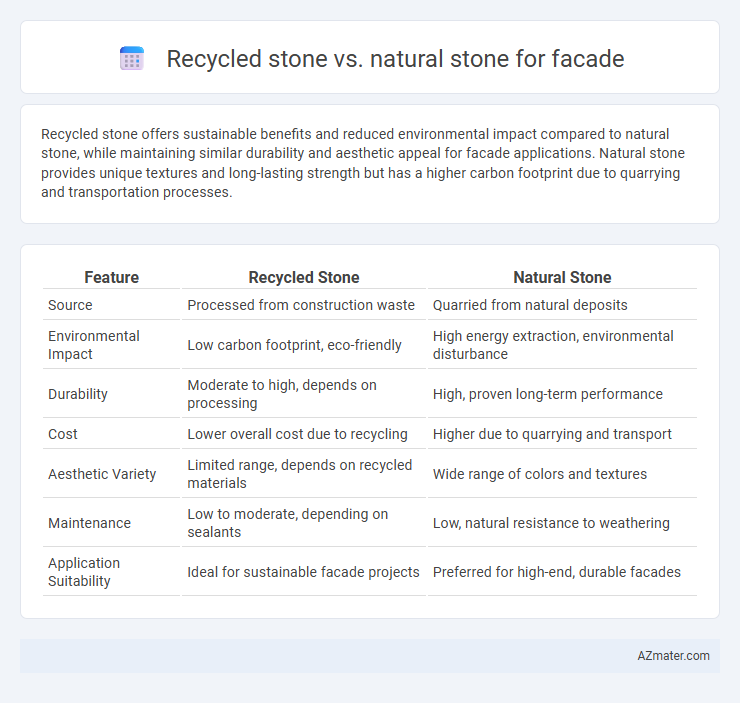Recycled stone offers sustainable benefits and reduced environmental impact compared to natural stone, while maintaining similar durability and aesthetic appeal for facade applications. Natural stone provides unique textures and long-lasting strength but has a higher carbon footprint due to quarrying and transportation processes.
Table of Comparison
| Feature | Recycled Stone | Natural Stone |
|---|---|---|
| Source | Processed from construction waste | Quarried from natural deposits |
| Environmental Impact | Low carbon footprint, eco-friendly | High energy extraction, environmental disturbance |
| Durability | Moderate to high, depends on processing | High, proven long-term performance |
| Cost | Lower overall cost due to recycling | Higher due to quarrying and transport |
| Aesthetic Variety | Limited range, depends on recycled materials | Wide range of colors and textures |
| Maintenance | Low to moderate, depending on sealants | Low, natural resistance to weathering |
| Application Suitability | Ideal for sustainable facade projects | Preferred for high-end, durable facades |
Introduction: Understanding Facade Stone Options
Recycled stone offers an eco-friendly alternative to natural stone for facades, reducing environmental impact by repurposing materials from construction waste. Natural stone, such as granite, limestone, and sandstone, provides durability, timeless aesthetics, and unique textures formed over millions of years. Evaluating factors like cost, environmental benefits, and visual appeal helps determine the best stone option for facade applications.
Environmental Impact: Recycled vs Natural Stone
Recycled stone significantly reduces environmental impact by minimizing quarrying activities and lowering carbon emissions associated with stone extraction and transportation. Natural stone extraction causes habitat disruption, deforestation, and high energy consumption, contributing to increased ecological footprint. Choosing recycled stone for facade applications supports sustainable construction by promoting resource efficiency and waste reduction.
Cost Comparison: Upfront and Long-Term Expenses
Recycled stone offers a cost-effective alternative to natural stone for facades, with upfront prices typically 20-40% lower due to reduced quarrying and processing expenses. Long-term, recycled stone can provide additional savings through lower maintenance costs and enhanced environmental benefits, reducing potential regulatory fees or sustainability-related charges. Natural stone, while initially more expensive, often has superior durability and aesthetic value that may justify higher upfront investments depending on project goals.
Aesthetic Differences: Texture and Color Variations
Recycled stone facades exhibit a diverse range of texture and color variations due to the composite nature of their source materials, creating unique, often patchwork-like aesthetics that contrast with the more uniform and consistent textures found in natural stone. Natural stone offers rich, organic patterns and gradual color transitions shaped by geological processes over millennia, delivering a timeless and classic appearance. The subtle irregularities in natural stone provide a sense of authenticity, while recycled stone's variability can enhance modern, eclectic facade designs with sustainable appeal.
Durability and Longevity
Recycled stone offers comparable durability to natural stone, as it is often composed of crushed and reprocessed materials that retain strength and resistance to weathering. Natural stone, such as granite or limestone, possesses inherent longevity due to its dense mineral composition and ability to withstand extreme environmental conditions over decades or centuries. Both materials perform well for facades, but natural stone typically exhibits superior long-term resilience and minimal maintenance requirements compared to recycled alternatives.
Installation Process and Challenges
Recycled stone facades offer easier installation due to their uniform shapes and lighter weight compared to natural stone, which often requires more precise cutting and handling due to irregular sizes. The installation of natural stone can present challenges such as increased labor time and the need for specialized tools to manage its hardness and weight. Moisture absorption and structural compatibility are key concerns during the installation of both materials, with recycled stone generally demonstrating improved performance in these areas due to modern fabrication techniques.
Maintenance Requirements
Recycled stone facades require less frequent sealing and are more resistant to staining and erosion due to their engineered composition, reducing overall maintenance efforts. Natural stone, while aesthetically timeless, often demands regular sealing and cleaning to prevent weather-induced wear and biological growth such as moss or lichens. Choosing recycled stone can lower long-term maintenance costs and labor, making it a practical option for building facades exposed to harsh environmental conditions.
Availability and Sourcing
Recycled stone for facades offers enhanced availability due to its reliance on repurposed materials sourced from demolition waste and industrial byproducts, reducing dependency on limited natural quarries. Natural stone sourcing often involves extensive quarrying processes that can be constrained by geographical location, environmental regulations, and depletion of reserves. Choosing recycled stone supports sustainable supply chains with more consistent access and lower environmental impact compared to the finite nature of natural stone extraction.
Sustainability Certifications and Standards
Recycled stone for facades often holds sustainability certifications such as LEED, BREEAM, and Cradle to Cradle, emphasizing reduced environmental impact through resource reuse and lower carbon footprints. Natural stone can also achieve certification under programs like the Natural Stone Council's Responsible Stone Certification, ensuring ethical quarrying and minimal environmental disruption. Both materials must comply with standards like ISO 14001 for environmental management, but recycled stone typically offers a stronger advantage in circular economy principles and waste reduction.
Choosing the Right Stone for Your Facade
Choosing the right stone for your facade requires understanding the differences between recycled stone and natural stone. Recycled stone offers eco-friendly benefits by repurposing materials, reduces environmental impact, and often comes at a lower cost, while natural stone provides unmatched durability, unique textures, and timeless aesthetic appeal. Balancing sustainability goals with long-term performance and design preferences ensures the best facade choice for your project.

Infographic: Recycled stone vs Natural stone for Facade
 azmater.com
azmater.com